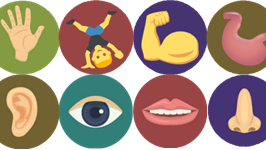Your nervous system is a complex network of signals connecting your brain and your body. There are eight major systems that connect your sensory organs through collections of nerve endings that gather sensory information to send to your central nervous system (brain and spinal cord). These systems give your brain information about your body and the world around you.
The “Foundational” Senses
Your foundational or proximal sensory systems give you information about your body and are some of the earliest to begin developing in utero. They include:
Tactile (touch) – located in your skin, touch receptors provide information about the world and specifically about the shape, size and texture of objects. Your skin is your body boundary and helps you understand your surroundings, to feel safe or alert you to danger, and to bond with loved ones.
Vestibular (head position and movement) – located in your inner ear, your vestibular system provides information about movement, balance, and your relationship to gravity. It lets you know if you are right side up or upside down. It also communicates if you are moving or still, as well as how quickly and in what direction you are moving.
ception
Proprioception (joint and muscle activation) – located within each of your muscles and joints, your proprioceptive system provides information about the weight and resistance of objects, muscle relaxation, muscle contraction, stretch, and other movements of your body.
ception
Interoception (internal sensations) – with receptors in each of your internal organs, your interoceptive system provides information about your bodily functions and is linked with how you feel emotion. Examples of interoception are hunger, thirst, breathlessness, pain, temperature, heartbeat, muscle tension, and bladder/bowel pressure.
The “Functional” Senses
The functional or distal sensory systems give you information about the world around you. They include:
Auditory (hearing) – located within your middle ears, your auditory system gives you information about what you hear.
Vision (sight) – located within your eyes, your visual system gives you information about what you see.
Gustatory (taste) – located within your mouth, your gustatory system gives you information about what you taste.
Olfactory (smell) – located within your nose, your olfactory system gives you information about what you smell.
Want to know more? Check out What is Sensory Processing?

